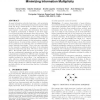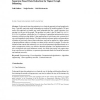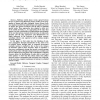267 search results - page 45 / 54 » On the approximability of influence in social networks |
PERSUASIVE
2009
Springer
14 years 3 months ago
2009
Springer
This paper presents a new model for understanding human behavior. In this model (FBM), behavior is a product of three factors: motivation, ability, and triggers, each of which has...
CORR
2012
Springer
12 years 4 months ago
2012
Springer
In many information networks, data items – such as updates in social networks, news flowing through interconnected RSS feeds and blogs, measurements in sensor networks, route u...
AAAI
2010
13 years 10 months ago
2010
Many problems require repeated inference on probabilistic graphical models, with different values for evidence variables or other changes. Examples of such problems include utilit...
JCO
2010
13 years 7 months ago
2010
Abstract Polynomial-time data reduction is a classical approach to hard graph problems. Typically, particular small subgraphs are replaced by smaller gadgets. We generalize this ap...
CORR
2010
Springer
13 years 3 months ago
2010
Springer
Malicious mobile phone worms spread between devices via short-range Bluetooth contacts, similar to the propagation of human and other biological viruses. Recent work has employed m...



